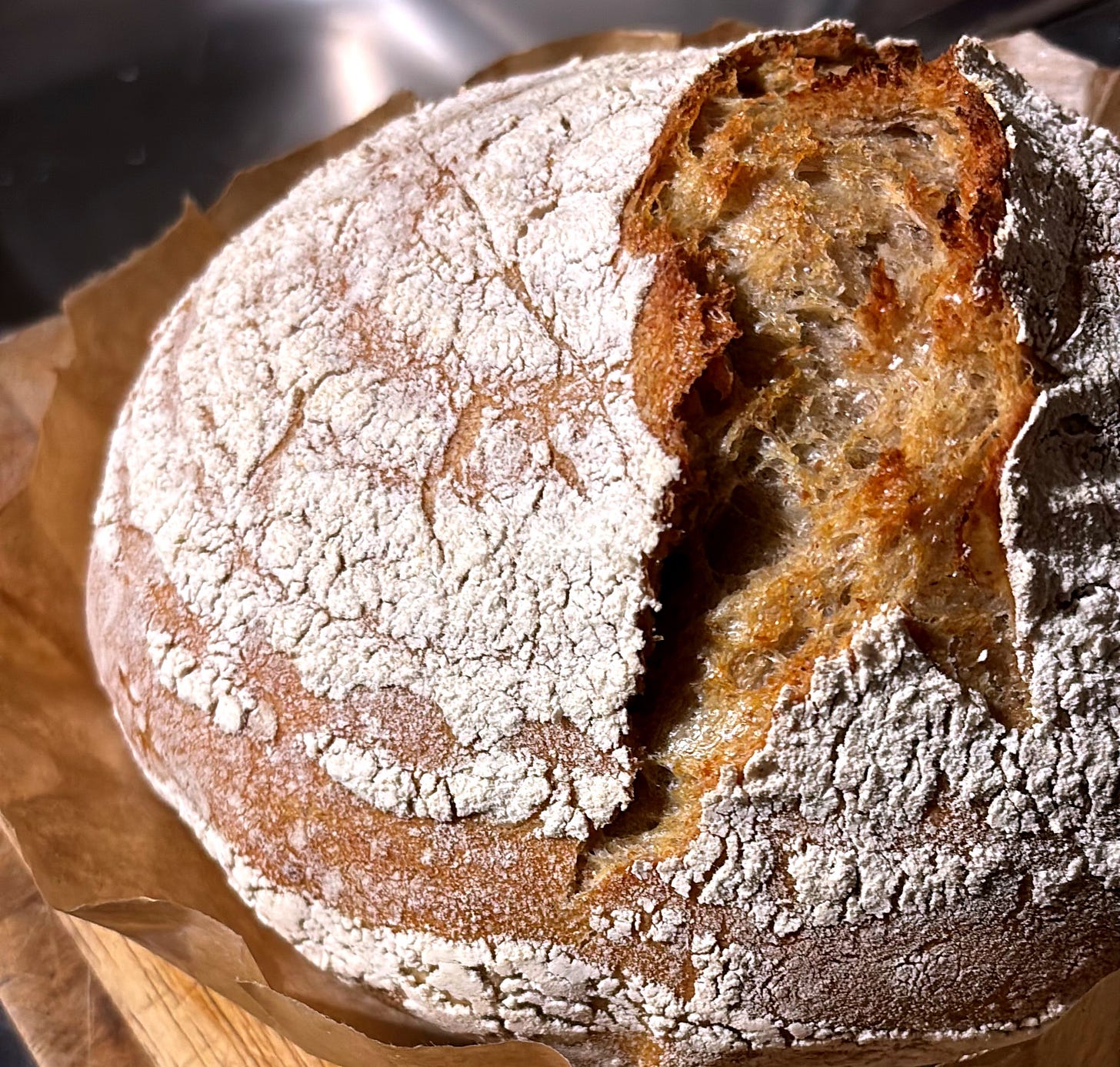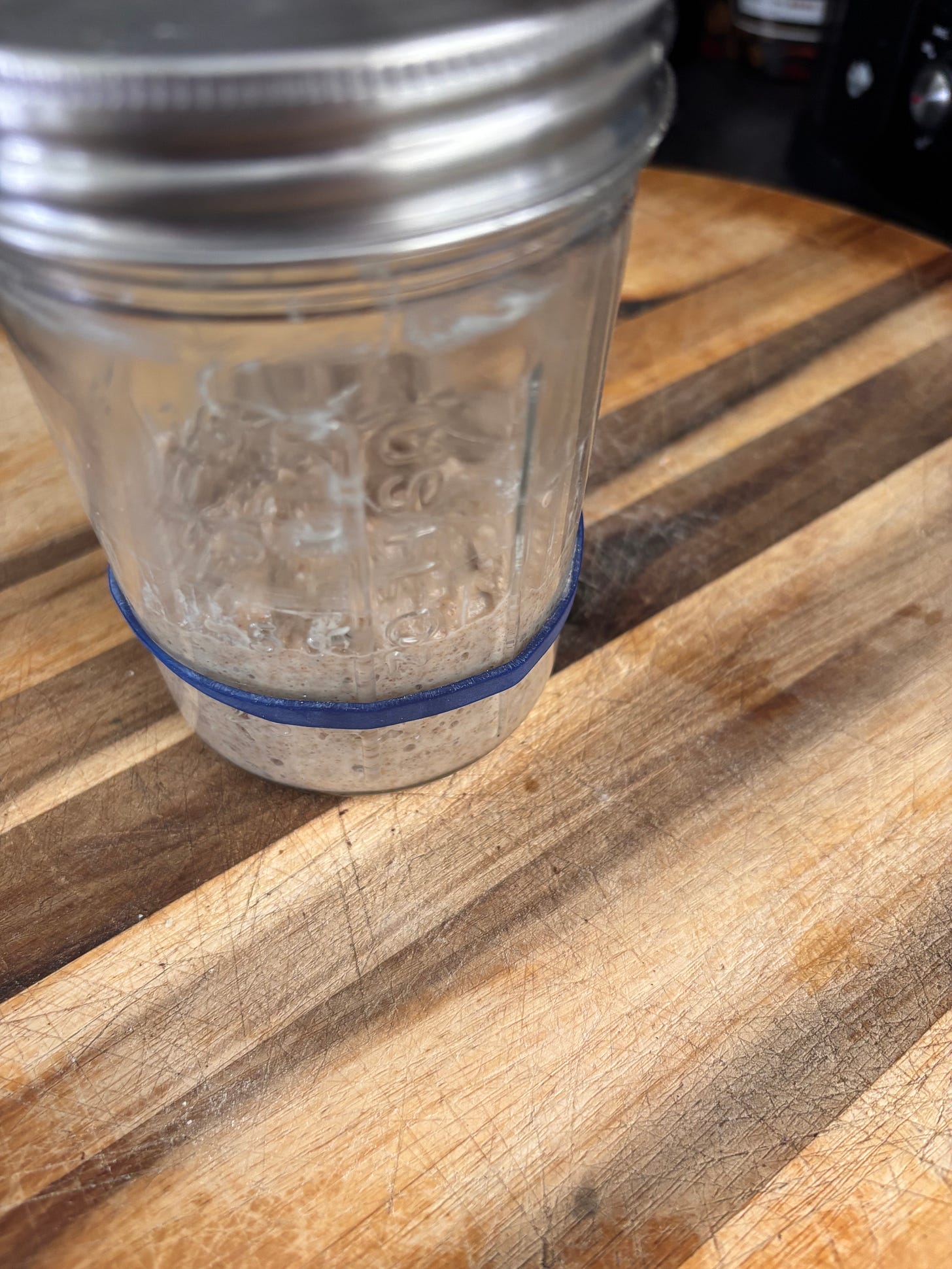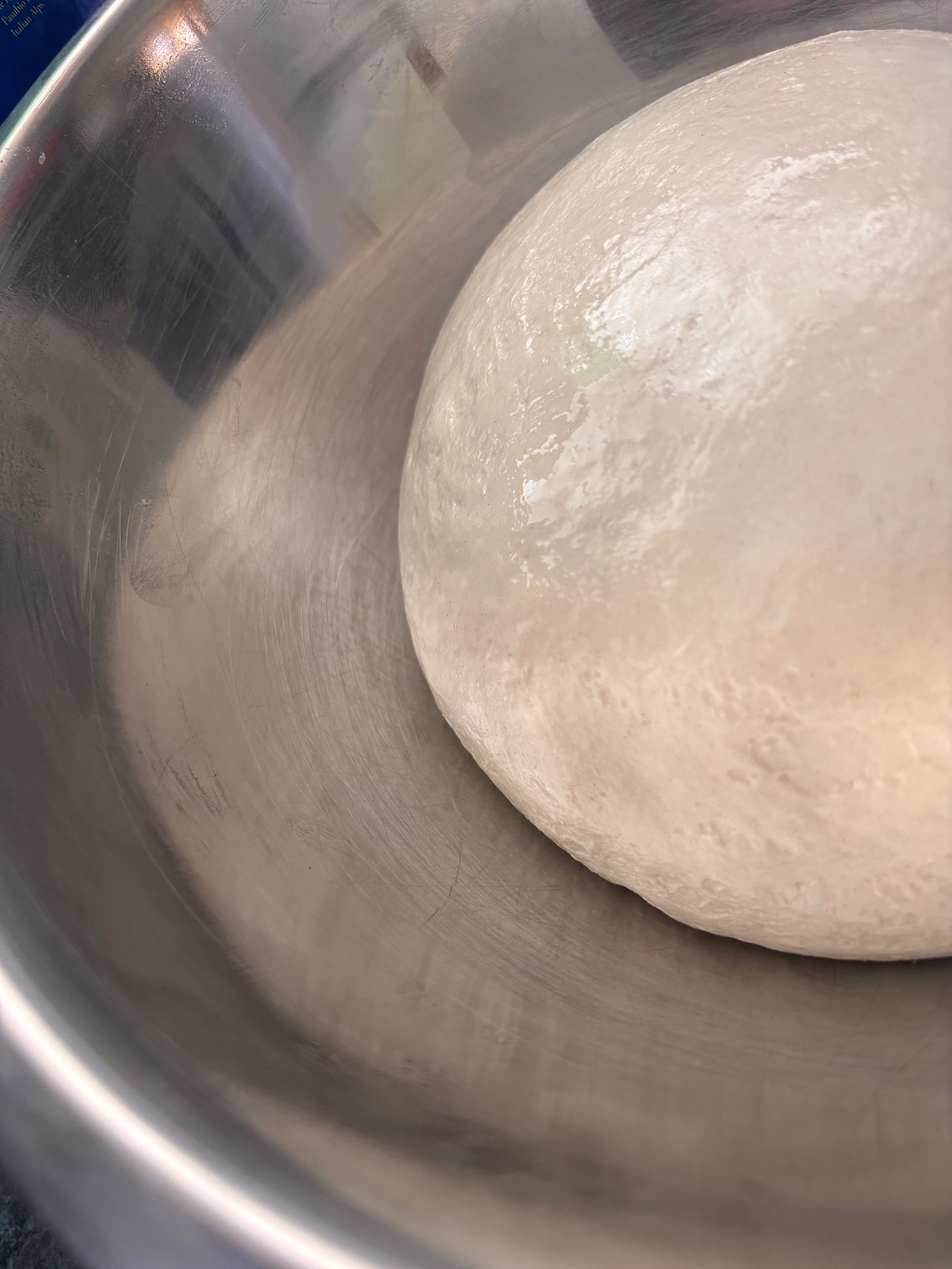Every Friday evening, I feed my sourdough starter and prepare for baking the weekly communion bread for our church service. I started this process a few years ago after COVID put everything on pause. This season was quite disruptive for pastors who are usually wired a certain way. It gave a group of people who come up with an abundance of ideas more time than we knew what to do with. I sometimes go back and look at the things I planned during that time and cringe. But one of them was the process of baking bread for the Lord’s Supper each Sunday for our church plant. This ritual has become an unexpected teacher that I never anticipated when I first decided to bake our church's communion bread myself.
It began, as many practices do in a church plant, with necessity. Our church needed communion bread, and we had just purchased these little cup-and-juice combo cups that were chaos in a pre-packaged form. Between the cardboard nature of the ‘bread’ and the extra pull back plastic that often resulted in a comical covering of the person in front, we needed a new system. There seemed something weird about celebrating the incarnation, God taking on flesh, entering the messiness of human existence, with sterile, factory-produced discs that bore no resemblance to actual bread. If we were going to speak of Christ as the bread of life, shouldn't we at least use bread that had been alive at some stage?
Enter sourdough starters: the sponsor of many people’s COVID experience. I have previously worked as a chef and had worked previously with bread, so I knew the basics. However, I am also a serial killer of sourdough starters, but stumbled upon a method that was fool proof and also gave me something crafty to do with the kids. It ticked all my boxes! Here was bread that truly lived, that required not just ingredients but a relationship, not just technique but patience. We even called him Sammy Sourdough Starter! Maybe you think this sounds a bit too serious – give me a break, it was COVID times! We took what we could get! The starter sitting in my fridge became a science and history lesson to tell and bore my kids with. Yet, then I had an idea. What if I baked bread each week for our church, taking time to pray for the people as I took time to prepare the bread?
The process itself has become a form of embodied theology for me. Each Friday morning, I remove the starter scrapings from the fridge and feed it flour and water, watching as it awakens throughout the day to bubbling life. It’s almost like this dough comes alive after slumbering through the week. I would pray that God would awaken the hearts of the people in our church and bring us together in worship as we broke this bread together. Yet, the fact that this happens through a few days also taught me something valuable.
Making sourdough teaches patience in ways that commercial yeast never could. I want a ‘active’ Christianity, a small sachet of 7g of religious yeast that requires no preparation or patience. Excitement on demand. As I learned, wild fermentation operates on its own timeline, influenced by temperature, humidity, and the particular ecosystem of microorganisms that have made themselves at home in my kitchen. And I have three teenage boys and a dog, I’m sure there are lots of microorganisms about! I cannot rush this process, cannot force the starter to activate more quickly because Sunday morning approaches with urgency. The bread will be ready when it's ready. This surrender to this sense of time has restructured my understanding of pastoral ministry itself. How often do we pastors fall into the trap of believing that spiritual transformation can be rushed, that conversion can be scheduled, that the work of the Spirit in the life of someone we are discipling can be? Waiting for activity, rising, and gluten development reminds me weekly that the most profound changes happen slowly, often invisibly, through processes I can nurture but never fully control. That’s before I even get my hands dirty!
Once the starter is added to flour, water and salt, the hard work begins. The tactile nature of this work grounds me in ways that sermon preparation never can. There's something profoundly pastoral about working with my hands, about creating something that will literally nourish the body alongside the soul. As I knead the dough, seeing it transform from shaggy mass to smooth, elastic potential, I'm reminded that my ministry is fundamentally about transformation. Not just of hearts and minds, but of the whole person, body and soul integrated. During COVID we were promised sourdough bread with limited involvement, no kneading, easy baking. Yet, in my experience, bread like my ministry, requires personal involvement, messiness, and hard work.
This physical engagement has taught me to pay attention to subtleties I might otherwise miss. The way the dough feels when it's properly developed. How conditions in different seasons affect rising time. These small observations have helped me think about my pastoral senses as well. In the past few years making me more attentive to the movements of grace in the congregational life of our church. I am hopefully more sensitive to the conditions that foster spiritual growth, more aware of the patient work required for transformation. Of course, I want things to always be the same, to not have to change, to be uniform and stable. Yet, there are times when I am hurried, stressed, weak, but this process centres me as I pray for God’s help and sustaining grace.
This weekly commitment itself has become a form of spiritual discipline that shapes my rhythm. Unlike spontaneous acts of service, this obligation returns every seven days, regardless of my energy level, sermon deadlines, or pastoral crises. This consistency has taught me about the difference between reactive ministry and the deeper faithfulness that sustains community life. There have been Friday evenings when I've felt too exhausted, too overwhelmed by pastoral demands to prepare with proper attention. Yet the bread must be ready by Sunday morning, and this constraint has forced me to discover reserves of dedication I didn't know I possessed! This process takes very little time, yet at the end I always feel better. Prepared. There are so many little things like this in ministry that we might avoid or see as insignificant. A text to someone who is struggling. A visit to an elderly person in church who lives alone. A cup of coffee with a friend to pray together. Ministry is not always rock-and-roll, but often simple and ordinary acts of everyday faithfulness.
The preparation of the bread also functions as my own spiritual preparation for Sunday. As I work the dough, I find myself reflecting on the week past, examining my relationships, considering my own need for forgiveness and renewal. The bread becomes a tool for self-awareness, reflecting back my own hunger for grace, reminding me that although I am preparing sermons and the bread, I have my own need to be fed. I have found there is something beautifully subversive about this practice in the context of modern pastoral ministry. There is a need to be seen to be doing something. To be impacting. To be a change maker. But this act of making bread was my little secret. Even up until recently no one knew I made the bread. The bread simply appeared on the communion table, ready to be broken and shared. This anonymity was surprisingly liberating, freeing me from the subtle pride that can creep into pastoral service. Then I was caught on by some church members! I suppose in writing this piece, the cat (bread?) is out of the bag now!
Each Sunday, I watch as the bread I've shaped and tended is torn apart, distributed among the hands of those in our family of faith. Any pride I had in a perfect crumb, or decorative scoring is quickly crushed. The bread fulfils its purpose not by remaining whole and beautiful, but by being broken and consumed. This weekly lesson in letting go has shaped how I think about all my pastoral work, all my attempts to serve others. I used to serve to be valued, now like the Baptiser, to decrease so that Jesus can increase.
Each Friday evening, as I dig the glass starter container out of the fridge for another week's offering, I'm reminded that this is how pastoral ministry often works. I’ve come to realise over the years that being a pastor is found not in preaching sermons or leading meetings, but in the faithful repetition of small acts of love, week after week, loaf after loaf. The bread teaches me that transformation cannot be rushed, that the most profound ministry often happens unseen, and that sometimes the most important work we do is simply showing up, week after week, to feed the people God has given us to serve.
If you’re interested in joining me in baking communion bread, I’ve written the recipe I use below. You can probably get a sourdough starter recipe online that you’ll need for the recipe.
Sourdough Bread
Makes Two Large Loaves
Ingredients
For the Sponge
350 g strong (bread) flour
100 g wholemeal flour
100 g active sourdough starter
480 g water (room temperature)
For the Dough
All of the sponge (from above)
570 g strong (bread) flour
15 g fine salt
120 g water (approx.—add as needed)
Equipment
Large mixing bowls
Wooden spoon (or dough hook + stand mixer)
Cling film or clean tea towel
Bannetons (or bowls lined with well‑floured tea towels)
Baking tray or baking stone
Sharp knife or lame for slashing
Method
Make the Sponge
In a large bowl, combine the strong flour, wholemeal flour, sourdough starter and 480 g water.
Stir with a wooden spoon (or paddle) for about 2 minutes, until fully combined and free of lumps.
Cover with cling film and set aside.
Bulk Fermentation (Sponge)
Let the sponge rest at room temperature for 1 – 12 hours, until bubbly and expanded.
Mix the Dough
Tip the risen sponge into a clean, large bowl.
Add 570 g strong flour and 15 g salt.
If using a stand mixer, attach the dough hook; if mixing by hand, use a sturdy spoon or your hands.
Develop the Dough
Gradually add up to 120 g water, a little at a time, while mixing/kneading, until you have a soft, slightly sticky dough.
By hand: knead 10 minutes.
In mixer: knead 5 minutes on low–medium speed.
First Rise
Shape the dough into a ball and place it in a lightly oiled bowl.
Cover with cling film or a clean, damp tea towel.
Let rest in a warm spot for about 45 minutes, until roughly doubled in size.
Pre‑Shape & Final Proof
Turn the dough out onto a lightly floured surface.
Divide into two equal pieces.
Gently shape each piece and place seam‑side up in well‑floured bannetons (or bowls lined with floured towels).
Cover and proof for 30–40 minutes, until puffy.
Bake
Preheat your oven to 200–220 °C (390–430 °F).
Carefully invert each loaf onto a lightly floured or oiled baking tray (or onto a preheated baking stone).
Slash the tops to allow expansion.
Bake for 30–35 minutes, until the crust is golden‑brown and the bottom sounds hollow when tapped.
Cool & Enjoy
Transfer the loaves to a wire rack and let cool completely (at least 1 hour) before slicing.
Tips & Variations
For a crisper crust, place a small pan of water on the oven floor during the first 10 minutes of baking to create steam.
Adjust hydration (water amount) slightly if your flour is very absorbent or your dough feels too wet/dry.
Store in a paper bag or loosely wrapped in a clean tea towel to keep the crust crisp.






I know, talk about nominative determinism! She's on Insta and Substack.
I know what I am doing this Friday night!! Great piece. Thank you